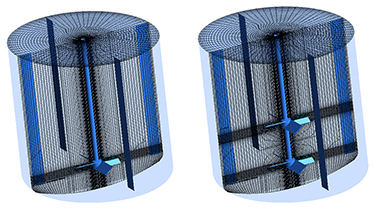Optimizing Solid Distribution in Continuous Stirred Tank Reactors
Latest News
September 30, 2014
 Dear Desktop Engineering Reader:
Dear Desktop Engineering Reader:
We baked the dinner rolls in the college cafeteria where I worked. This involved a floor-standing mixer, a lot of yeast, pounds of flour and copious amounts of liquids. One of the big pranks was to sneak up to the mixer and ratchet up the mixing speed to high, soaking the baker with a gooey white gunk. Yuck, yuck. Once when this happened, an engineer in training launched into a rambling discourse on how the higher speed adversely affected the cloud height in the vessel. He offered to experiment to find the optimal speed to mix the batter. Suffice to say, the cooks demurred.
 It’s a safe bet that people running stirring tanks in industries as diverse as pharmaceuticals, wastewater treatment, chemicals and petrochemicals probably do not play with their hydrodynamic materials. But they certainly need simulation to discover the optimal distributions of solids in their mixing vessels. Today’s Check it Out link takes you to “Optimizing Solid Distribution in Continuous Stirred Tank Reactors,” an online tutorial that looks at how you can leverage ANSYS CFD (computational fluid dynamics) technologies to simulate solid suspensions in mechanically stirred tanks. It’s quite engaging.
It’s a safe bet that people running stirring tanks in industries as diverse as pharmaceuticals, wastewater treatment, chemicals and petrochemicals probably do not play with their hydrodynamic materials. But they certainly need simulation to discover the optimal distributions of solids in their mixing vessels. Today’s Check it Out link takes you to “Optimizing Solid Distribution in Continuous Stirred Tank Reactors,” an online tutorial that looks at how you can leverage ANSYS CFD (computational fluid dynamics) technologies to simulate solid suspensions in mechanically stirred tanks. It’s quite engaging.
The backdrop to the discussion is this: Continuously stirred tank reactors are used for processes like crystallization, dissolution and solid catalyst reactions. Each of these applications generally means you’re mixing solids and liquids. The key to achieving the right outcome is optimizing the solid distribution in the vessel. CFD simulations provide a good way to study what’s going on in the mixing process, enabling you to visualize the distribution of solids and cloud heights.
The variables in a given mixing process are, of course, legion. Your mixing tank has impellers, baffles and other geometric properties. The process involves complex swirling flows, particles of different sizes and masses, fluid patterns as well as multiple interaction forces.
This ANSYS tutorial looks at what ANSYS CFD technology brings into the mix. Among these technologies are a fully automated template for creating your mixing tank, impeller, baffles, probes and sparger geometry; validated turbulence models to simulate swirling flows in a stir tank; and validated Eulerian-Granular models.
The heart of the tutorial is a 5-minute 30-second video located mid-page. The video provides a step-by-step demonstration of how you can use an assortment of ANSYS CFD technology to determine the optimal strategy to predict solid distribution in a continuous stirred reactor accurately.
The sketch and objective of the demonstration is to study the impact of the Simonin turbulent dispersion force (TDF) on a small, high-loading solid suspension. The demo begins with a description of the mixing application under investigation. It then proceeds to an in-depth explanation of the Simonin TDF modeling strategy available in ANSYS CFD and how it differs from traditional approaches to mixing simulations. Next are screen animations of the virtual stirring tank showing the cloud height as predicted with Simonin TDF and without it. The demo ends with a comparison of simulation results to experimental data.
The landing page also links to a pair of additional tutorials on using the ANSYS automated mixing tank template and turbulence modeling. Also available is a technical white paper titled “Using Computational Modeling to Control and Optimize the Crystallization Process.”
A five-page download (registration required), the gist of the paper is that many of the process parameters in the crystallization process are coupled and are difficult to study or analyze separately. Hydrodynamic issues that affect crystal shape and size such as the kinetics of nucleation and growth as well as super-saturation ratios are described. The paper suggests that a successful approach for analyzing the crystallization process starts with studying components individually then gradually coupling the phenomena.
ANSYS always seems to put a lot of thought into its tutorials, and the “Optimizing Solid Distribution in Continuous Stirred Tank Reactors” upholds that tradition very well. The landing page itself provides an easy to grasp introduction to a complex phenomena, and the video is a top-notch presentation that’s worth the click even if mixing solids is not part of your work routine. Good stuff.
Thanks, Pal. – Lockwood
Anthony J. Lockwood
Editor at Large, Desktop Engineering
Go to the “Optimizing Solid Distribution in Continuous Stirred Tank Reactors” tutorial here.
Subscribe to our FREE magazine, FREE email newsletters or both!
Latest News
About the Author
Anthony J. Lockwood is Digital Engineering’s founding editor. He is now retired. Contact him via [email protected].
Follow DE





